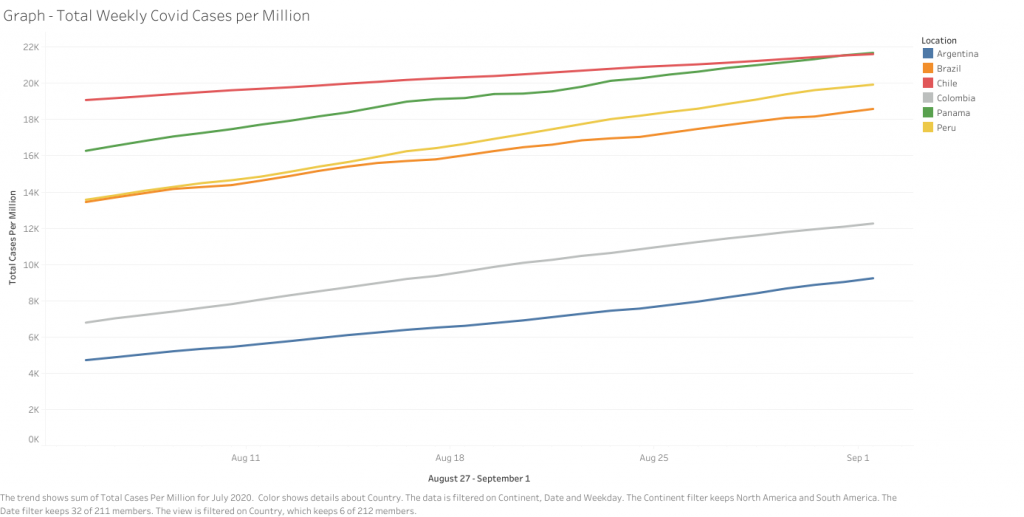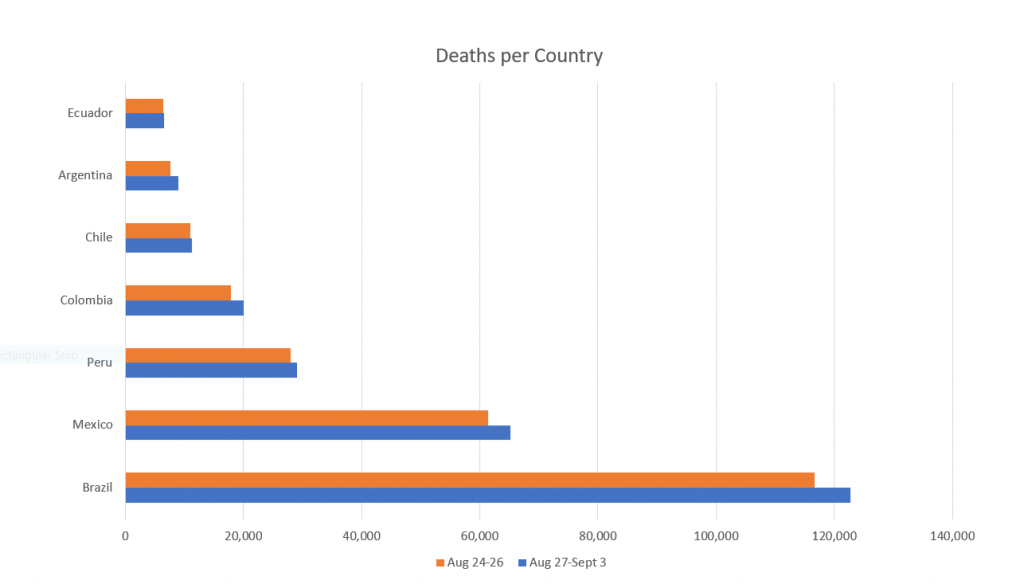What you should know
- With over a quarter of all confirmed COVID-19 cases and nearly a third of all related deaths, Latin America is the world’s worst affected region. Brazil, Peru, Colombia, Mexico and Argentina remain among the 10 countries with the most cases in the world.
- On September 1, the Pan American Health Organization warned that some countries in the Caribbean area, as well as Peru, are starting to see a rise in new infections, after the numbers of new cases had declined.
- According to the UN, the COVID-19 pandemic will widen the poverty gap between women and men, pushing 47 million more women and girls into poverty.
By the numbers
- Cases by country: Brazil (3,674,176) #2 worldwide, Peru (607,382) #6 worldwide, Mexico (568,621) #7 worldwide, Colombia (562,128) #8 worldwide, Chile (400,985) #10 worldwide, Argentina (359,638) #12 worldwide.
- Prevalence rate (confirmed cases per million people): Chile (20,949) #4 worldwide, Panama (20,436) #6 worldwide, Peru (18,383) #8 worldwide, Brazil (17,267) #10 worldwide, Colombia (11,030) #21 Cases by country: Brazil (3,952,790) #2 worldwide, Peru (657,129) #5 worldwide, Colombia (624,069) #7 worldwide, Mexico (606,036) #8 worldwide, Argentina (428,239) #10 worldwide, Chile (413,145) #11 worldwide, [view full list]
- Prevalence rate (total cases per million people): Panama (21,625) #4 worldwide, Chile (21,581) #5 worldwide, Peru (19,884) #8 worldwide, Brazil (18,574) #11 worldwide, Colombia (12,243) #19 worldwide, Bolivia (10,023) #25 worldwide, [view full list]
- Deaths – total reported in the region: Brazil (122,681) #2 worldwide, Mexico (65,241) #4 worldwide, Peru (29,068) #9 worldwide, Colombia (20,052) #11 worldwide, Chile (11,321) #14 worldwide, Argentina (8,971) #18 worldwide, Ecuador (6,571) #21 worldwide, [view full list]
Quarantine & reopening plans
With cases continuing to rise in the region, several countries remain under lockdown conditions to help stop the spread of COVID-19.
- Argentine President Alberto Fernández extended quarantine measures until September 20. The country currently holds the world’s longest COVID-19 lockdown (effective since March 20).
- Peru extended its national emergency until September 30 and prolonged lockdown conditions in some of the country’s worst-affected areas.
Other countries have chosen to move forward with reopening plans, seeking to reignite their economies following months of restrictions.
- Colombia’s coronavirus lockdown was partially lifted on September 1, even as the country reported 389 new coronavirus deaths, taking the death toll to 20,052. Bars and restaurants are to remain closed until at least the end of September, with limited exceptions for open-air dining.
- On August 30, Salvadoran President Nayib Bukele announced 20 consecutive days of a decrease in COVID-19 cases. The country began its economic reopening on August 24, allowing for services such as public transportation. In-person classes for schools and universities remain suspended through December 31.
- On August 25, Panama announced plans to reduce movement restrictions and open up additional economic sectors, starting on September 7. The plan is conditional upon meeting certain COVID-19 control criteria, including reaching a mortality rates less than three percent.
International travel restrictions
- Several countries had border closure regulations that were set to expire on August 31. Colombia and Chile extended their border closures until October 1, while Argentina has not made clear when it will reopen its borders. Peru has also extended its border closure, along with its state of emergency, until September 30.
- On September 1, Bolivia announced a reopening of air borders for international flights; all passengers must have a negative COVID-19 test within 7 days of arrival.
Economies in focus
Economic impact
- The International Labour Organization warned that the crisis will have a tremendous impact on vulnerable groups, including women, informal workers, and the young labor force.
- According to new figures, the region could lose up to 45 million jobs. As of August 2020, unemployment in Chile had reached 13.1 percent, up from 8.3 percent in 2019. Nearly one in five Colombians are jobless. With 13.3 percent unemployment, Brazil is experiencing the worst unemployment rate in its history.
- On September 2, Chile’s central bank softened its economic contraction numbers, projecting a deceleration in 2020 between -4.5 percent and -5.5 percent; the easing of lockdown measures and support for household income has had an economic ripple effect. In June, it had predicted a yearly contraction between -5.5 percent and -7.5 percent.
Economic relief
- Starting September 1, Argentina increased its pension benefits by 7.5 percent, seeking to protect the country’s most vulnerable citizens in the context of the pandemic.
- On September 1, the Chilean congress passed a bill that will ease requirements to access unemployment benefits. On August 27, it approved the creation of a technical and specialized body to support small- and medium-sized enterprises.
- On August 31, Bolivia’s Ministry of Economy and Public Finance announced the deferral of loan payments until January 2021.
- The Central American Bank for Economic Integration (CABEI) approved a $400 million loan to seven regional countries and the Dominican Republic for the acquisition and distribution of a coronavirus vaccine.
- The Colombian government authorized a $370 million loan to Avianca, following the airline’s filing for Chapter 11 bankruptcy.
- The IMF and Ecuador reached an agreement on a new $6.5 billion fund facility to support Ecuador’s economic policies.
- On August 26, Brazil’s Ministry of Economy approved $959 million to fund programs that will combat the economic effects of the crisis and advance socio-environmental development in the states of Minas Gerais and Santa Catarina.
For the Latest Global Economy News: The Atlantic Council’s Global Business and Economics Program produces a weekly, invitation-only financial note. If you would like to join the list, send an email to request an invitation.
Health + innovation
- Argentina, Brazil, and Ecuador are investigating cases of COVID-19 reinfection after Hong Kong reported the world’s first case of reinfection last week. Risk of reinfection could create an entirely new set of challenges for Latin America.
- The Johnson & Johnson Phase III clinical trials for a COVID-19 vaccine will be held in Argentina, Brazil, Chile, Colombia, Peru, and Mexico. The company is still waiting for regulatory approval in Chile, Argentina, and Mexico. In Peru, trials are expected to get under way in mid-September.
- On August 26, Mexico announced that it would take part in clinical trials of a vaccine produced by Italy’s National Institute for Infectious Diseases. The country is also making deals to access a COVID-19 vaccinewith countries including France, Russia, and Cuba.
- Argentina, Brazil, Chile, Colombia, Dominican Republic, Mexico, and Venezuela are among the 80 countries that have submitted expressions of interest to the WHO’s global COVAX plan that aims to ensure equal access for all.
- The Mexican laboratory Avimex announced that it is preparing human tests for its COVID-19 vaccine. Human trials will be carried out after preclinical test results in rodents are confirmed. This is Mexico’s most advanced vaccine project.
- Maduro announced on August 30 that Venezuela will participate in Phase III clinical trials for Russia’s COVID-19 vaccine, the efficacy of which is highly debated by international health officials.
A message from PhRMA: Biopharmaceutical companies have the goal to defeat the coronavirus. The industry is working closely together and collaborating in unprecedented ways to speed up the development of a vaccine and treatments. Watch this video to learn more.
Country Focus
- Argentina: Argentina passed Chile to claim the 10th spot in most cases globally, with 417,75 infections and 8,730 confirmed deaths. From August 25 through September 1, cases rose by 9.9 percent, the most among the top 20 countries.
- Brazil: In August 2020, the number of fires in the Brazilian Amazon was the second highest in a decade, nearing the crisis levels of 2019. In the Amazonas state, indigenous communities remain the most at risk of contagion and extinction, due to a lack in immunological protection and living without basic sanitation facilities and far from healthcare facilities.
- Colombia: The Colombian government announced new tax incentives for companies from Asia, Europe, and Latin America that are looking to relocate to the Andean nation. The initiative is part of a broader plan to attract $11.5 billion in non-hydrocarbon related foreign direct investment a year by 2022. The government is also focused on new investments to push job creation, with the pandemic having caused the unemployment rate to spike to almost 25 percent.
By the numbers (continued)
- Cases by country (continued): Bolivia (117,267), Ecuador (114,309), Dominican Republic (94,979), Panama (93,552), Guatemala (74,893), Honduras (61,769), Venezuela (47,756), Costa Rica (42,184), El Salvador (25,904), Source: worldometers.info
- Prevalence rate (continued): Argentina (9,460), Domincan Republic (8,741), Costa Rica (8,268), Suriname (6,960), Ecuador (6,463), Honduras (6,220), Bahamas (5,778) Mexico (4,692), Guatemala (4,168), El Salvador (3,990), Source: worldometers.info
- Deaths (continued): Bolivia (5,101), Guatemala (2,778), Panama (2,018), Honduras (1,888), Dominican Republic (1,738), El Salvador (731), Costa Rica (443), Venezuela (391), Paraguay (231), Nicaragua (137), Cuba (91), Uruguay (43), Belize (10). Source: worldometers.info
Quick take


